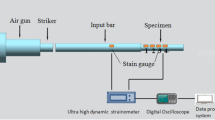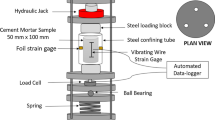Abstract
Tensile relaxation characteristics are important for the crack resistance of concrete members subjected to restrained contraction, for example bonded overlays and patch repairs. In the experimental research discussed in this paper, relaxation characteristics were measured for mortar specimens subjected to constant strain which corresponded to stresses close to the tensile strength of the mortar. Relaxation was found to relieve a considerable portion of tensile stresses. Ultimate relaxation values ranged from 20 to 45%, depending on w/c ratio and specimen age. As expected, a decrease in specimen age and an increase in w/c ratio resulted in increasing relaxation values. The rate of stress decay was found to be rapid, with approximately 80% of the ultimate relaxation occurring in the first 12 h after loading. A basic equation for the prediction of time development of relaxation is proposed and future research needs are discussed.










Similar content being viewed by others
References
Pigeon M, Bissonette B (1999) Bonded concrete repairs—tensile creep and cracking potential. Concr Int 21:31–35
Amba JC, Balayssac JP, Détriché CH (2010) Characterisation of differential shrinkage of bonded mortar overlays subjected to drying. Mater Struct 43:297–308
Banthia N, Gupta R (2009) Plastic shrinkage cracking in cementitious repairs and overlays. Mater Struct 42:567–579
Bentur A, Kovler K (2003) Evaluation of early age cracking characteristics in cementitious systems. Mater Struct 36:183–190
Beushausen H, Alexander MG (2005) Crack development in bonded concrete overlays subjected to differential shrinkage: a parameter study. In: Proceedings of the international conference on concrete repair. Rehabilitation and Retrofitting, South Africa, pp 1053–1058
Pane I, Hansen W (2002) Early age creep and stress relaxation of concrete containing blended cements. Mater Struct 35:92–96
Pigeon M, Toma G, Delagrave A, Bissonnette B, Marchand J, Prince JC (2000) Equipment for the analysis of the behaviour of concrete under restrained shrinkage at early ages. Mag Concr Res 52(4):297–302
Emmons H, Vaysburd AM (1995) Performance criteria for concrete repair material, phase 1. Technical Report REMR-CS-47. US Army Corps of Engineers, April 1995
Bentur A (2001) Early-age shrinkage and cracking in cementitious systems. Concr Sci Eng 3:3–12
Loser R, Leemann A (2009) Shrinkage and restrained shrinkage cracking of self-compacting concrete compared to conventionally vibrated concrete. Mater Struct 42:71–82
Rostàsy FS, Krauss M, Budelmann H (2002) Planungswerkzeug zur Kontrolle der frühen Rissbildung in massigen Betonbauteilen, Teil 1–7, Bautechnik 79 (2002), Hefte 7–12, Berlin, Germany, 2002 (in German)
Gutsch AW (2002) Properties of early age concrete—experiments and modeling. Mater Struct 35:76–79
Yuan Y, Marsszeky M (1994) Restrained shrinkage in repaired reinforced concrete elements. Mater Struct 27:375–382
Kordina K, Schubert L, Troitzsch U (2000) Kriechen von Beton unter Zugbeanspruchung (Creep of concrete subjected to tensile stress), Deutscher Ausschuss für Stahlbeton, Heft 498, Beuth Verlag, Berlin, Germany, 2000 (in German)
Morimoto H, Koyanagi W (1995) Estimation of stress relaxation in concrete at early ages. In: Proceedings: RILEM symposium on thermal cracking in concrete at early ages. Chapman & Hall, London, pp 95–102
Gutsch A, Rostásy FS (1995) Young concrete under high tensile stresses—creep relaxation and cracking. In: Proceedings: RILEM symposium on thermal cracking in concrete at early ages. Chapman & Hall, London, pp 111–116
Beushausen H, Alexander MG (2006) Failure mechanisms and tensile relaxation of bonded concrete overlays subjected to differential shrinkage. Cem Concr Res 36:1908–1914
Beushausen H, Alexander MG (2007) Localised strain and stress in bonded concrete overlays subjected to differential shrinkage. Mater Struct 40:189–199
Grubbs F (1979) Procedures for detecting outlying observations in samples. Technometrics 11(1):1–21
Carlswärd J (2005) Shrinkage cracking of steel fibre reinforced self compacting concrete overlays; Test methods and theoretical modelling. Doctoral Thesis, Luleå University of Technology, Luleå, Sweden
Östergaard L, Lange DA, Altoubat SA, Stang H (2001) Tensile basic creep of early-age concrete under constant load. Cem Concr Res 31:1895–1899
Author information
Authors and Affiliations
Corresponding author
Rights and permissions
About this article
Cite this article
Beushausen, H., Masuku, C. & Moyo, P. Relaxation characteristics of cement mortar subjected to tensile strain. Mater Struct 45, 1181–1188 (2012). https://doi.org/10.1617/s11527-012-9825-2
Received:
Accepted:
Published:
Issue Date:
DOI: https://doi.org/10.1617/s11527-012-9825-2




